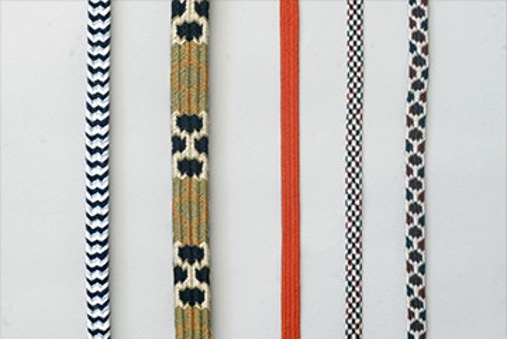Date
12.11.2021 (Sat.) – 03.06.2022 (Sun.)
Hours
11:00 AM – 06:00 PM
Location
JAPAN HOUSE Gallery, Level 2
Fee
Complimentary
KUMIHIMO: The Art of Japanese Silk Braiding by DOMYO is the first exhibition in the United States to explore the history and art of Japanese silk braiding, or kumihimo (braided cords). The JAPAN HOUSE touring exhibition is produced by Yusoku Kumihimo Domyo (Domyo), a Tokyo-based company that has been making braided silk cords by hand since 1652.
The tradition of kumihimo began in Japan in the sixth century in the Imperial Court and Buddhist temples, and by the ninth century, during the Heian period (794–1185), it reached its golden age. Braided silk cords of many styles and patterns were used for aristocratic costumes, interior furnishings and decorations, musical instruments, and religious equipment for temples and shrines. From around the tenth century, kumihimo was also used for swords and armor by members of the military. Later, the cords became important decorative elements on kimonos and kimono accessories for well-to-do members of the general population. These braided silk cords are still featured in traditional dress and settings; they are also incorporated into contemporary fashion and inspiring braiding applications in engineering, architecture, and even space technology.
This historical survey presents the evolution of kumihimo over centuries in Japan. With materials provided by Domyo, the exhibition introduces some of the most important braiding techniques and tools and shows innovative ways kumihimo is used today.
Welcome Message

Meher McArthur
Art & Cultural Director
JAPAN HOUSE Los Angeles
*To watch the video in full screen, please click play and then the YouTube icon on the lower right-hand corner.
Introduction


The exhibition opens with an introduction to the tradition of braiding, a technique used to create cords by gathering together three or more threads (or groups of threads) and crossing them over each other diagonally following a particular order. Braiding is distinct from weaving and knitting and has a long history in many cultures, including Tibet, Bhutan, and Peru. A map of places with ancient and sophisticated braiding traditions is featured, along with examples of braids from these diverse areas.
Part 1 | The History of Kumihimo in Japan


The first section of the exhibition presents a historical overview of braiding in Japan. It includes information about the earliest evidence of simple braiding from ancient Japanese burial sites dating to the early Jōmon period, about five to six thousand years ago.
Part 2 | The Structure of Kumihimo
The second section of the exhibition focuses on the structure of kumihimo braiding. The most important tools in kumihimo are the wooden braiding stands, frames over which the strands of thread are laid during braiding. Large-scale marudai (“round stands”) and takadai (“tall stands”) strung with colorful silk strands and bobbins evoke the process of silk braiding. Videos, photographs, silk samples, and tools help visitors to learn about the structure of kumihimo braiding.
Part 3 | The Future of Kumihimo


In the final section, the exhibition focuses on the ways in which braided silk cords are incorporated into contemporary fashion and design. The section includes works that highlight new kumihimo designs by Domyo, clothing reworked by garment modelist Akira Hasegawa that encompasses kumihimo braiding, and an installation by the UTokyo Tachi Lab at Tokyo University.
Gallery Photos
*To view the flipbook in full screen, please click on the "Fullscreen" icon on the lower right-hand corner from the window above.
Exhibition-Related Programs

Replica of Heian-period Hirao Sash, Courtesy of Domyo
Check Event

Heel-less shoes by Noritaka Tatehana in collaboration with Ryukobo for the ‘Edo Tokyo Rethink’ online exhibition organized by the Edo Tokyo Kirari Project Check Event

Exhibition Brochure & Handout
The KUMIHIMO exhibition brochure and handout are available for download.
Exhibition Credits
Presented by | JAPAN HOUSE Los Angeles
Exhibition Production | Yusoku Kumihimo Domyo (Kiichiro Dōmyō)
Curation | Mari Hashimoto
Exhibition Design | Rei Mitsui





